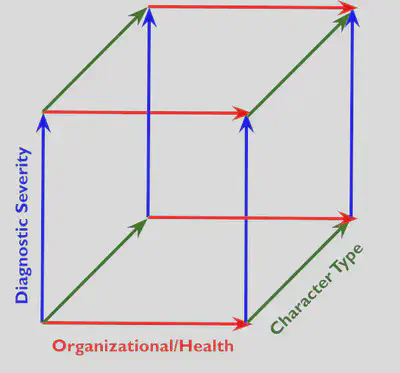Psychodynamic Personality Classification (As Ice Cream)

- The Diagnostic Severity Axis: Amount of Ice Cream and Ingredients
- The Organizational/Health Axis: State Change of Ice Cream
- The Character Axis: Flavor Category of Ice Cream
Let’s look at each one and see what it contributes to our understanding of personality!
The Diagnostic Severity Axis: Ratio of Ice Cream and Ingredients

We all have a personality. The severity axis is a continuum that shows how functional your personality is to how problematic it is. Are your personality traits serving you, working against you, or even keeping you from functioning in society? It’s not categorical, because we all move along this continuum at certain times, but usually we stay in a small range of the continuum. If it’s not clinically distressing or impairing, it’s toward the Structure end of the continuum. The more problematic, the further toward the Disorder end you might be. Let’s look at it through an ice cream lens!
We might think of this axis as the ratio of ice cream to the bowl or cone. Do you have enough ice cream to fill your bowl? If you have too little ice cream, or certain personality traits, you might have a psychological empty spot that you try to fill with other things (i.e. spending, love, indiscriminate partners, substances, food). If you have too much ice cream, is it overflowing onto others or about to fall off the cone because it’s hard to balance? We can also think of the ratio of flavor and ingredients in the ice cream. Is there too little flavoring to actually taste it, or is there too much flavor? Eating a drop of vanilla extract is gross, but put an appropriate amount in the ice cream, and it’s delicious! Same with ingredients. If there’s too little of certain ingredients in your ice cream, it’s like having pretty significant personality deficits that make it hard to function in our social world. If there’s too much of certain ingredients, it’s overwhelming, and the excessiveness of certain “flavors” or personality traits don’t fit into society well either. So this axis is all about balance and functioning!
The Organizational/Health Axis: State Change of Ice Cream

Early in psychology’s journey of conceptualizing personality, there were two categories: psychotic and neurotic. Eventually, someone discovered that not everyone fits neatly into two categories (😱🤯). Some theorists called those who did not fit in either category: “Borderland.” This term was later adapted to become a continuum from psychotic to neurotic, with the space in between called “Borderline.” (Note: The borderline movement in the continuum was forced back into a category for the DSM-III’s Borderline Personality Disorder - an unfortunate move in our field).
On the continuum, the further we are on the neurotic side, the more rigid and frozen we become - sometimes even literally! The ice cream might become freezer burnt or even just become ice with its atoms super close together and structured. It’s hard to scoop out this ice cream and may be painful. The psychotic part of the continuum (melted) is when we are out of touch with reality. The ice cream has melted and is now liquid. Its original state is lost, just like reality. Then there’s the big space in between called borderline (melting) where we might start to melt. We are still ice cream, but we might be falling apart and melting when we start moving toward the psychotic end. And when we move back toward the neurotic end, the melting is refrozen and icy. We can move along this continuum because we’re not static beings. Even when healthy, we can have snippets of disintegrating or moving toward unhealthy. This organizational axis is essentially an axis of health, but we still don’t want extremes.
The Character Axis: Flavor Category of Ice Cream

So this is a great place to remind you that while we categorize and label personality information into neat boxes in order to understand and better “consume” the study of personality, limiting yourself to fit into a box is not helpful. The study of personality helps us to identify patterns and concepts, but it falls immensely short of describing an individual person. You are your own unique flavor, and that is something wonderful!
References:
- Lingiardi, V., & McWilliams, N. (Eds.). (2017). Psychodynamic diagnostic manual: PDM-2 (2nd ed.). The Guilford Press.
